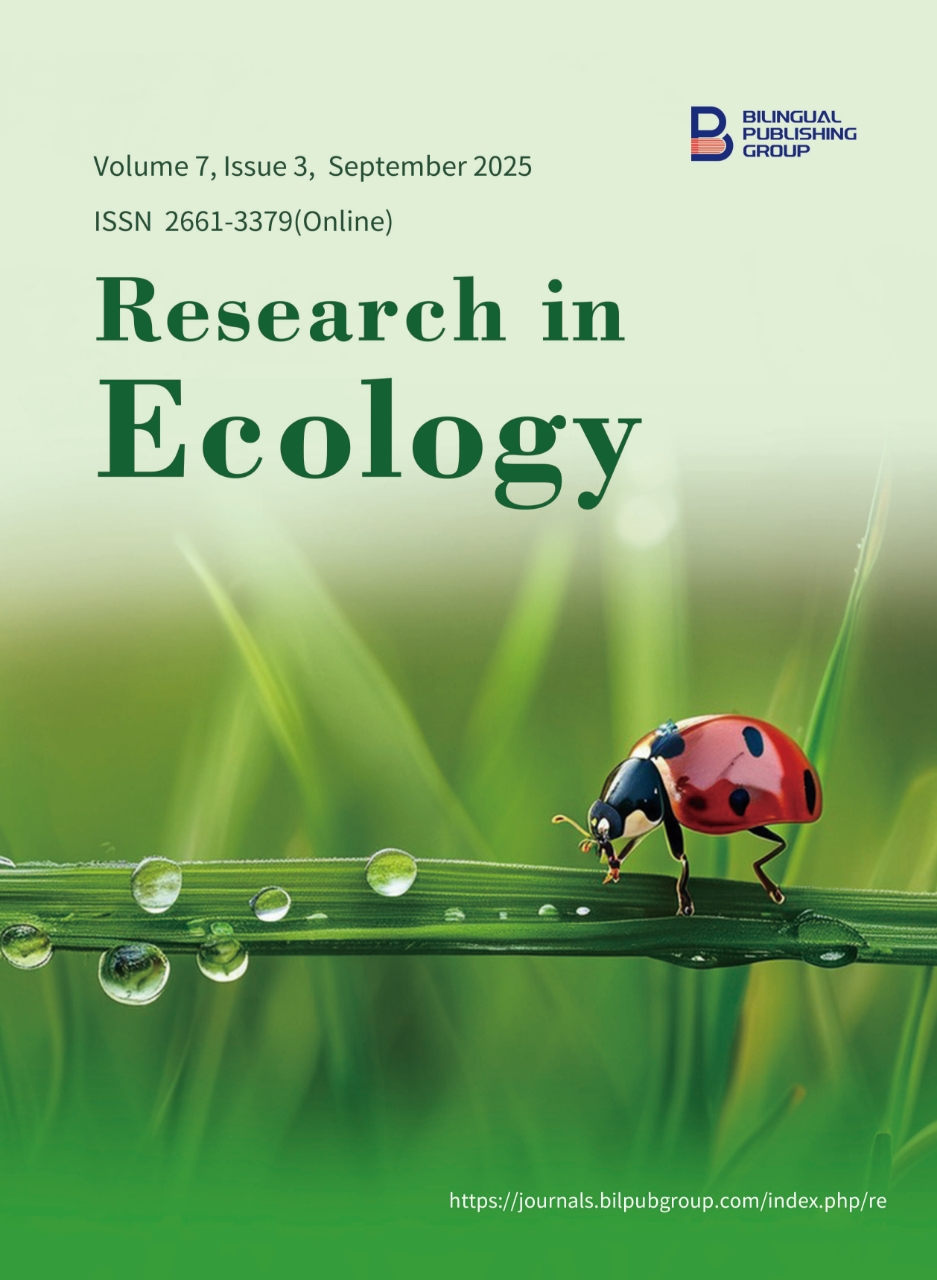
The Impact of Intensified Aridization Caused by Moisture Deficit on the Productivity of Grain Crops in Northern Kazakhstan
DOI:
https://doi.org/10.30564/re.v7i3.10487Abstract
The article examines the impact of increased aridization of the territory due to an increase in air temperature, reduced precipitation, and the formation of moisture deficiency on grain yields in Northern Kazakhstan. The most important result of the work is the revealed inverse relationship between grain yields and the temperature of the growing season: low-yielding years are associated with high temperatures and droughts, and high-yielding years are associated with lower temperatures and an optimal ratio of heat and moisture. The novelty of this study is the use of the method of hydrological and climatic calculations in identifying the nature of temperature variability and precipitation in the territory of Northern Kazakhstan for the modern period (1991–2020) compared with the base period (1961–1990). At all the studied meteorological stations, there is a tendency for the average annual temperature and the temperature of the growing season to increase: in the forest-steppe zone with an average warming intensity of 0.3–0.33 °C per decade; in the steppe zone by 0.2–0.43 °C per decade; and in the growing season by 0.2–0.7 °C per decade. The air temperature in the steppe zone is rising more intensively than in the forest-steppe zone, and precipitation in the forest-steppe zone has changed more than in the steppe zone. An increase in the average annual air temperature during the growing season (May–August), combined with a shortage of atmospheric moisture or a constant amount of it, led to an increase in the degree of aridization of the territory, an increase in the frequency of droughts in the steppe zone of Northern Kazakhstan.
Keywords:
Aridization; Air Temperature; Precipitation; Moisture Deficiencies; Crop Yield; Northern KazakhstanReferences
[1] Zolotokrylin, A.N., 2019. Global warming, desertification/degradation, and droughts in arid regions. Izvestiya Rossiiskoi Akademii Nauk. Seriya Geograficheskaya. (1), 3–13. DOI: https://doi.org/10.31857/S2587-5566201913-13
[2] Belgibayev, M.E., 2012. Influence of global climate warming on desertification processes in the steppe zone of Kazakhstan. In Proceedings of the VI International Symposium and VIII International School-Seminar "Geoecological Problems of Steppe Regions", Orenburg, Russia, 18–23 June 2012; pp. 118–121.
[3] Kirchengast, G., Pichler, M., 2025. A traceable global warming record and clarity for the 1.5°C and well-below-2°C goals. Communications Earth & Environment. 6, 402. DOI: https://doi.org/10.1038/s43247-025-02368-0
[4] Paromov, V.V., Zemtsov, V.A., Kopysov, S.G., 2017. Climate of Western Siberia during the phase of slowing warming (1986–2015) and forecasting of hydro-climatic resources for 2021–2030. Izvestiya Tomskogo Politekhnicheskogo Universiteta. Inzhiniring Georesursov. 328(1), 62–74.
[5] Matsuyama, H., Watanabe, T., Zemtsov, V.A., 2023. Extreme drought around Tomsk, Russia in summer 2012 in comparison with other regions in Western Siberia. Water. 15(3), 388. DOI: https://doi.org/10.3390/w15030388
[6] Ganeshi, N.G., Takaya, Y., Komatsu, K.K., et al., 2025. Prominent impacts of snow–hydrological processes on near-surface temperature variability over Western Siberia. Journal of Hydrology. 658, 133187.
[7] Belonenko, G.V., Tusupbekov, Zh.A., Ryapolova, N.L., 2015. Formation and features of water and heat exchange in landscape provinces of the West Siberian Plain. Problemy Regional’noy Ekologii. (3), 174–179.
[8] Akshalov, K., Baisholanov, S., Aueskhanov, D., et al., 2022. Analysis of agrometeorological conditions of the growing season and yield of spring wheat in the Akmola region of the Republic of Kazakhstan. Proceedings of the Main Geophysical Observatory named after A.I. Voeikov. (605), 41–57.
[9] Baisholanov, S.S., Baybazarov, D.K., 2013. The influence of climate change on the yield of spring wheat. Hydrometeorology and Ecology. 1(68), 16–23.
[10] Tusupbekov, Z.A., Mezentseva, O.V., Kusainova, A.A., 2022. Assessment of long-term variability of heat-water balance characteristics during the growing season of Northern Kazakhstan. In: Ensuring sustainable development: agriculture, ecology and earth science (AEES 2021), London (virtual), 27–29 October 2021; p. 012067. DOI: https://doi.org/10.1088/1755-1315/1010/1/012067
[11] Karnatsevich, I.V., 2008. Statistical forecasts of phase-inhomogeneous meteorological extremes. Omskiy Nauchnyy Vestnik. 2(71), 62–65.
[12] Federal State Budgetary Institution VNIIGMI-MCD, 2025. Meteorological information site. Available from: http://meteo.ru/data/ (cited 11 June 2025).
[13] Republican State Enterprise Kazhydromet, 2025. Available from: https://meteo.kazhydromet.kz/database_meteo/ (cited 11 June 2025).
[14] Hydrometeorological Center of Russia, 2025. Available from: https://meteoinfo.ru/climatcities (cited 11 June 2025).
[15] Kumar, B.P., Pinjarla, B., Joshi, P.K., et al., 2021. Long term spatio-temporal variations of seasonal and decadal aridity in India. Journal of Atmospheric Science Research. 4(3), 29–45. DOI: https://doi.org/10.30564/jasr.v4i3.3475
[16] Nesterenko, Y.M., Bakirov, F.G., Nesterenko, M.Y., et al., 2020. Nature of arid zones and nature management. Naukoemkiye Tekhnologii: Saint Petersburg, Russia. p. 289.
[17] Gebregiorgis, G., Zeweld, W., Hdgot, A., et al., 2024. Lessons learned from adopting sustainable agricultural practices to address food insecurity and climate change risks: Opportunities, constraints, and limitations. Research on World Agricultural Economy. 5(3), 60–75. DOI: https://doi.org/10.36956/rwae.v5i3.1131
[18] Baisholanov, S., Akshalov, K., Mukanov, Y., et al., 2025. Agro-climatic zoning of the territory of Northern Kazakhstan for zoning of agricultural crops under conditions of climate change. Climate. 13, 3. DOI: https://doi.org/10.3390/cli13010003
[19] Schierhorn, F., Hofmann, M., Adrian, I., et al., 2020. Spatially varying impacts of climate change on wheat and barley yields in Kazakhstan. Journal of Arid Environments. 178, 104164. DOI: https://doi.org/10.1016/j.jaridenv.2020.104164
[20] Karatayev, M., Clarke, M., Salnikov, V., et al., 2022. Monitoring climate change, drought conditions and wheat production in Eurasia: The case study of Kazakhstan. Heliyon. 8(1), e08660. DOI: https://doi.org/10.1016/j.heliyon.2021.e08660
[21] Syromyatnikov, D., Salimova, S., Kolpak, E., et al., 2024. Analyzing the impact of competitiveness factors on increasing grain production in Kazakhstan and Russia. Heliyon. 10(23). DOI: https://doi.org/10.1016/j.heliyon.2024.e39751
[22] Ilyin, Y.M., Baldanov, N.D., Darzhaev, V.H., et al., 2024. The crop yield of spring wheat under conditions of the aridized climate. BIO Web of Conferences. 93, 02010. DOI: https://doi.org/10.1051/bioconf/20249302010
[23] Teleubay, Z., Yermekov, F., Rustembayev, A., et al., 2024. Comparison of climate change effects on wheat production under different representative concentration pathway scenarios in North Kazakhstan. Sustainability. 16(1), 293. DOI: https://doi.org/10.3390/su16010293
[24] Kusainova, A.A., Mezentseva, O.V., 2019. The influence of spatial variability in air temperature at the beginning of the growing season on the formation of runoff and evaporation in Kazakhstan and southern Western Siberia. Astrakhanskiy Vestnik Ekologicheskogo Obrazovaniya. 4(52), 60–65.
[25] Kusainova, A.A., Mezentseva, O.V., Tusupbekov, Z.A., 2020. Influence of precipitation variability and temperature conditions on the yield of grain crops in Northern Kazakhstan. IOP Conference Series: Earth and Environmental Science. 548, 042026. DOI: https://doi.org/10.1088/1755-1315/548/4/042026
Downloads
How to Cite
Issue
Article Type
License
Copyright © 2025 Aisulu Amirkhanovna Kusainova, Galina Nikolaevna Chistyakova, Gaukhar Makhanovna Zhangozhina

This is an open access article under the Creative Commons Attribution-NonCommercial 4.0 International (CC BY-NC 4.0) License.




 Aisulu Amirkhanovna Kusainova
Aisulu Amirkhanovna Kusainova






